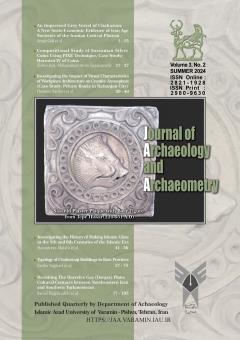Investigating the Impact of Visual Characteristics of Workplace Architecture on Creative Atmosphere (Case Study: Private Banks in Rafsanjan City)
محورهای موضوعی : Art
Hossein Sardari
1
,
Hossein Kalantari Khalil Abad
2
,
Marjan khanmohammadi
3
![]()
1 - Department of Architecture, Arak Branch, Islamic Azad University, Arak, Iran.
2 - Department of Architecture, Karaj Branch, Islamic Azad University, Alborz, Karaj, Iran.
3 - Department of Architecture, Islamic Azad University of Karaj, Alborz, Iran
کلید واژه: visual features, Workplace architecture, performance, employees, Private Banks,
چکیده مقاله :
In addition to its functional aspects, architecture holds a deeper significance that communicates with the observer or user of the architectural work. Perception plays a crucial role in various fields, as an individual's perceptions, emotions, and mental states, alongside visual characteristics, can lead to diverse or multiple interpretations, allowing the landscape to be understood in myriad ways. Every architectural design maintains a connection with its surroundings through its distinct visual attributes. Aligning with this notion, the present study aims to elucidate the visual aspects of workplace architecture and its impact on the performance of private bank employees in Rafsanjan city. This research adopts an applied developmental goal and employs a descriptive-analytical methodology. Data collection utilized both field methods (public questionnaires) and a combined approach (quantitative-qualitative) for data analysis. Descriptive and inferential statistical techniques were applied using SPSS software. The findings revealed a direct correlation between the visual characteristics of workplace architecture and job performance in private bank branches in Rafsanjan. Thus, emphasizing visual elements in bank architecture holds significant importance, as these factors can influence employee performance, alertness levels, and concentration at work. The visual features of workplace architecture directly impact visual and psychological needs. Therefore, to enhance the performance quality of banks, these characteristics must be regarded as pivotal factors in workplace environments.
In addition to its functional aspects, architecture holds a deeper significance that communicates with the observer or user of the architectural work. Perception plays a crucial role in various fields, as an individual's perceptions, emotions, and mental states, alongside visual characteristics, can lead to diverse or multiple interpretations, allowing the landscape to be understood in myriad ways. Every architectural design maintains a connection with its surroundings through its distinct visual attributes. Aligning with this notion, the present study aims to elucidate the visual aspects of workplace architecture and its impact on the performance of private bank employees in Rafsanjan city. This research adopts an applied developmental goal and employs a descriptive-analytical methodology. Data collection utilized both field methods (public questionnaires) and a combined approach (quantitative-qualitative) for data analysis. Descriptive and inferential statistical techniques were applied using SPSS software. The findings revealed a direct correlation between the visual characteristics of workplace architecture and job performance in private bank branches in Rafsanjan. Thus, emphasizing visual elements in bank architecture holds significant importance, as these factors can influence employee performance, alertness levels, and concentration at work. The visual features of workplace architecture directly impact visual and psychological needs. Therefore, to enhance the performance quality of banks, these characteristics must be regarded as pivotal factors in workplace environments.
1. Ahmadi, E., 2015, investigation of the effects of architecture and work environment on job satisfaction in industrial environments, the third scientific research conference of new horizons in the sciences of geography and architectural planning and urban planning of Iran, Tehran.
2. Bagheri, F., and Lalbar, A., 2017, examining the ergonomic effect of color on the decoration of the work environment and the morale and productivity of employees, the second international conference on new research achievements in humanities and social and cultural studies, Karaj.
3. Balesh Zar, A., and Tabedi, M., 2017, The effect of environmental architecture on the productivity and level of job performance of employees of Islamic Azad University, Shiraz branch, the third national conference on organizational transformation and innovation with the approach of the Iranian Islamic model of progress, Mashhad.
4. Rezaei, S., and Masrouri Jannett, N., 2019, examining the quality of office environments on the level of vitality and job satisfaction (case example: office space in a bank), the 7th National Conference of Modern Studies and Research in the field of Geography, Architecture and urban planning of Iran, Tehran.
5. Azimi, Maryam, 1400, characteristics and solutions for designing creative work environments, the 8th national conference of modern researches in the field of geography, architecture and urban planning of Iran, Tehran.
6. Gulabchi, M., and Yousefi, S., and Farozanfar, M., 2013, prioritizing the role of physical and architectural factors of the work environment in improving the performance of personnel in project-oriented organizations, the third international conference on construction industry, Tehran.
7. Harrison, E.M.; Schmied, E.A.; Easterling, A.P.; Yablonsky, A.M.; Glickman, G.L.2020, A Hybrid Effectiveness-Implementation Study of a Multi-Component Lighting Intervention for Hospital Shift Workers. Int. J. Environ. Res. Public Health, 17, 9141
8. Moidi, M., and Kamelnia, Hamed, 2016, Investigating the impact of the physical environment on employee satisfaction in the workplace (a case study of the administrative staff of Ferdowsi University of Mashhad), the third international conference on new horizons in civil engineering, architecture and urban planning ,Tehran.
9. Papatsimpa, C.; Linnartz, J.-P.2020, Personalized Office Lighting for Circadian Health and Improved Sleep. Sensors, 20, 4569


